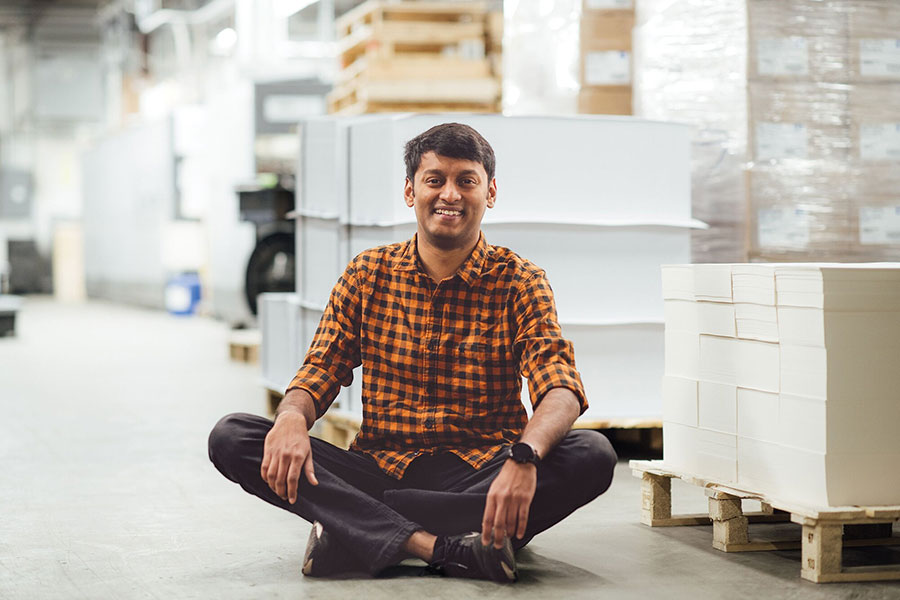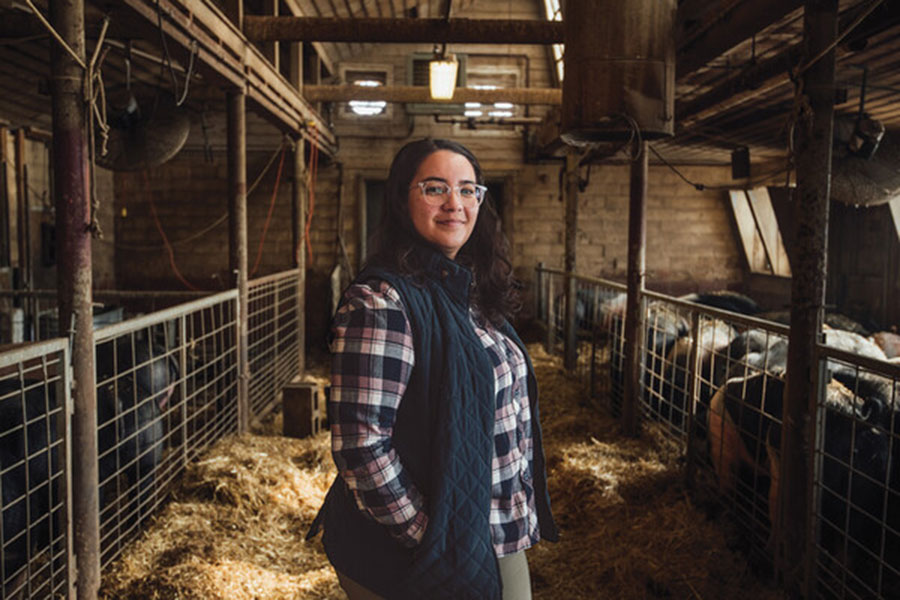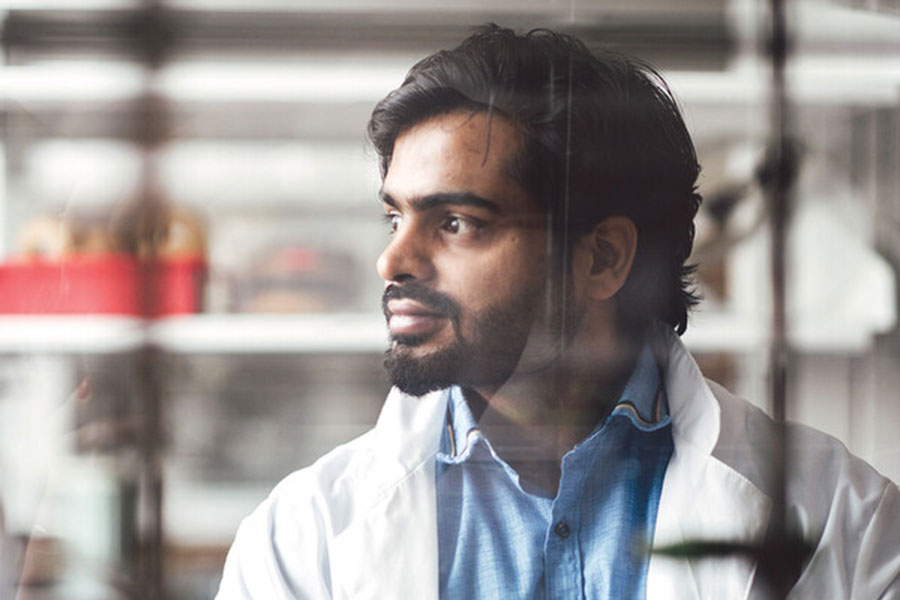
Each year U of M master’s and doctoral students take to the stage—literally—to make a case for their research and dissertation projects. But unlike a formal defense, time is of the essence: Each presenter is allowed exactly three minutes and one static slide to convey the gist of complex research that’s taken them years to complete.
It’s the 3-Minute Thesis competition (3MT), an event that aims to hone students’ academic, presentation, and communication skills.
“To be successful as the leaders of tomorrow, our students must also be able to communicate complex ideas to people who aren’t experts in their discipline,” says Scott Lanyon, vice president and dean of the Graduate School.
Lanyon hopes the annual 3MT event also highlights the wide range of research happening at the U of M.
This is a condensed snapshot of what the three 2023 competition winners said about their research.
First place: Koushik Sampath – Wet to Dry Paper
Bioproducts and biosystems science, engineering, and management PhD
College of Science and Engineering and College of Food, Agricultural and Natural Resource Sciences
You may not realize this, but the paper industry uses a tremendous amount of energy to dry wet sheets of paper. That’s a problem, because paper is among the most used commodities in our daily lives, from toilet paper to cardboard to printing paper and much more.
According to the Department of Energy, the hundred-billion-dollar paper industry uses twice as much energy as it takes to power every single home in the United States. Currently, the industrial technology for drying paper involves using a hot surface and hot air to dry the wet sheets. (Imagine using a kitchen hot plate and a hair dryer to make pancakes!) This procedure stretches back to the early 18th century, so it’s obviously not state-of-the-art.
Post Covid, lots of things have changed in our world. Businesses have moved online so printing paper use has been reduced. But the use of thicker forms of paper like cardboard—which requires 5 to 10 times more energy to produce—is on the rise. It’s as if the amount of energy being used by this industry rose from powering twice the number of homes in the U.S. to powering four or five times as many in just a decade.
How do we tackle this mess, the burden of an energy crisis, and the need to sustain the next generation? This is where my research kicks in.
Radio signals and microwaves could save the day. It turns out that using sound radio signals and microwaves in a very concentrated spot is a more efficient and effective way to dry paper than the current industrial technology. With this modified tech, there could be a 30 to 50 percent improvement in the amount of energy, time, and costs involved with the whole paper-drying process.
Our initial results show up to a 60 percent improvement—and further research will tell us more about how this innovation could help revolutionize the paper industry and save energy.
Second place: Miranda Medrano – Health on Pig Farms
Veterinary medicine PhD
College of Veterinary Medicine

I’m going to tell a little story about the history of pigs in America. Pigs were first introduced to the continent by Hernando de Soto in 1539, when pigs were largely free range and thrived with little human input. That’s until the 18th century, when confining pigs in pens began.
Throughout the 1900s, the U.S. swine industry saw an overall decrease in the number of pig farms—but an increase in the number of pigs per farm. So indoor facilities became necessary, as indoor pigs were easier to manage, required less land use and less labor, and could be raised year-round in colder climates like Minnesota.
Today, despite an increase of indoor pig farms, some farmers still raise their pigs with outdoor access. They do this for many reasons, including improved animal welfare, environmental sustainability, and the opportunity to sell locally through farmer’s markets and co-ops. Unfortunately, these farms have largely been ignored by the U.S. veterinary industry.
That led to my research question: Does raising pigs with outdoor access lead to an increase in disease frequency when compared to pigs raised indoors?
To answer this, I identified more than 200 pig farms in Minnesota that raise pigs with outdoor access, sent those farmers a survey, and even visited some of them to test their pigs for disease. From this, I learned that one farm had as few as four pigs and another had more than 500. I also learned that nearly a third of them had never consulted with a veterinarian. Among the farms I tested, only 35 percent tested positive for a disease that wreaks havoc in farms that raise pigs indoors.
The results suggest that outdoor pig farms do differ in their farming practices and the types of diseases that their pigs might encounter. This highlights the importance of veterinarians and the veterinary industry in addressing specific concerns of outdoor pig farms.
Information gathered from this project will go a long way toward ensuring the longevity of these farms and improving the pig’s health.
People's choice: Anuj Kumar Singh – Shaping the Future of Cancer Therapy
Chemistry MS
Swenson College of Science and Engineering, U of M Duluth

When I was an undergrad, I wondered why our chemistry professor hadn’t come to class for a few days. After a while we found out that he had cancer and was receiving chemotherapy, which caused him to lose weight and become very weak.
We all know that chemotherapy has a lot of tough side effects, but why do we still use it? I wondered if there is a better option for cancer treatment without these harsh side effects. That’s what I’m researching, and I’m working to develop a nontoxic alternative to these medicines to make cancer treatment safer and more efficient.
Using organic chemistry, I prepared my own compound derived from an already FDA-approved drug called niclosamide. Reports suggest that a high dose of this can be tolerated, and it’s safe to use in both humans and animals.
So what’s the problem? The problem is absorption in the body: If the medicine does not absorb, it’s not going to get to the cancer tumor target. Imagine you have a special ingredient for a recipe but it acts like a rock that won’t dissolve. If I figure out how to convert that hard rocklike ingredient into a powdered form, it can break down in the recipe.
I’m working on something similar for niclosamide, trying to change its structure by carefully designing it in the lab so that I can increase the solubility of the compound. That means I can increase the absorption of it in the body, making it readily available to the cancer tumor target.
I tested my compound on breast cancer cells, and found it has more potency as compared to the original niclosamide on the market. (But remember, this testing was outside a living body.) In the next phase of testing, I administered my drug to mice to evaluate how well they tolerated it and to monitor any potential side effects.
What did I find? That my compound didn’t cause any significant weight loss or behavioral changes. Based on these results, it shows potential to be a game changer in cancer therapy. I’m really excited for further testing and hopefully for human studies as well.
I’m also really thankful to my undergrad professor, who is now a cancer survivor. His journey motivates me to make this world a beautiful place where people can be happy, even facing something as challenging as cancer.
This story was adapted from Minnesota Alumni magazine
- Categories:
- Agriculture and Environment
- Health




